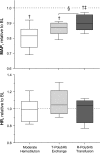Tissue oxygenation after exchange transfusion with ultrahigh-molecular-weight tense- and relaxed-state polymerized bovine hemoglobins
- PMID: 20061539
- PMCID: PMC2838544
- DOI: 10.1152/ajpheart.01022.2009
Tissue oxygenation after exchange transfusion with ultrahigh-molecular-weight tense- and relaxed-state polymerized bovine hemoglobins
Abstract
Hemoglobin (Hb)-based O(2) carriers (HBOCs) constitute a class of therapeutic agents designed to correct the O(2) deficit under conditions of anemia and traumatic blood loss. The O(2) transport capacity of ultrahigh-molecular-weight bovine Hb polymers (PolybHb), polymerized in the tense (T) state and relaxed (R) state, were investigated in the hamster chamber window model using microvascular measurements to determine O(2) delivery during extreme anemia. The anemic state was induced by hemodilution with a plasma expander (70-kDa dextran). After an initial moderate hemodilution to 18% hematocrit, animals were randomly assigned to exchange transfusion groups based on the type of PolybHb solution used (namely, T-state PolybHb and R-state PolybHb groups). Measurements of systemic parameters, microvascular hemodynamics, capillary perfusion, and intravascular and tissue O(2) levels were performed at 11% hematocrit. Both PolybHbs were infused at 10 g/dl, and their viscosities were higher than nondiluted blood. Restitution of the O(2) carrying capacity with T-state PolybHb exhibited lower arterial pressure and higher functional capillary density compared with R-state PolybHb. Central arterial O(2) tensions increased significantly for R-state PolybHb compared with T-state PolybHb; conversely, microvascular O(2) tensions were higher for T-state PolybHb compared with R-state PolybHb. The increased tissue Po(2) attained with T-state PolybHb results from the larger amount of O(2) released from the PolybHb and maintenance of macrovascular and microvascular hemodynamics compared with R-state PolybHb. These results suggest that the extreme high O(2) affinity of R-state PolybHb prevented O(2) bound to PolybHb from been used by the tissues. The results presented here show that T-state PolybHb, a high-viscosity O(2) carrier, is a quintessential example of an appropriately engineered O(2) carrying solution, which preserves vascular mechanical stimuli (shear stress) lost during anemic conditions and reinstates oxygenation, without the hypertensive or vasoconstriction responses observed in previous generations of HBOCs.
Figures






Similar articles
-
Balance between vasoconstriction and enhanced oxygen delivery.Transfusion. 2008 Oct;48(10):2087-95. doi: 10.1111/j.1537-2995.2008.01834.x. Epub 2008 Jul 9. Transfusion. 2008. PMID: 18631171 Free PMC article.
-
Safety profile of high molecular weight polymerized hemoglobins.Transfusion. 2021 Jan;61(1):212-224. doi: 10.1111/trf.16157. Epub 2020 Oct 26. Transfusion. 2021. PMID: 33104250
-
Isovolemic exchange transfusion with increasing concentrations of low oxygen affinity hemoglobin solution limits oxygen delivery due to vasoconstriction.Am J Physiol Heart Circ Physiol. 2008 Nov;295(5):H2212-8. doi: 10.1152/ajpheart.00751.2008. Epub 2008 Oct 3. Am J Physiol Heart Circ Physiol. 2008. PMID: 18835914 Free PMC article.
-
Effects of the molecular mass of tense-state polymerized bovine hemoglobin on blood pressure and vasoconstriction.J Appl Physiol (1985). 2009 Nov;107(5):1548-58. doi: 10.1152/japplphysiol.00622.2009. Epub 2009 Sep 10. J Appl Physiol (1985). 2009. PMID: 19745190 Free PMC article.
-
Oxygen-carrying blood substitutes: a microvascular perspective.Expert Opin Biol Ther. 2004 Jul;4(7):1147-57. doi: 10.1517/14712598.4.7.1147. Expert Opin Biol Ther. 2004. PMID: 15268681 Review.
Cited by
-
Biocompatibility of the oxygen carrier polymerized human hemoglobin towards HepG2/C3A cells.Heliyon. 2023 May 2;9(5):e15878. doi: 10.1016/j.heliyon.2023.e15878. eCollection 2023 May. Heliyon. 2023. PMID: 37215914 Free PMC article.
-
Simulation of NO and O2 transport facilitated by polymerized hemoglobin solutions in an arteriole that takes into account wall shear stress-induced NO production.Biophys Chem. 2012 Mar;162:45-60. doi: 10.1016/j.bpc.2011.12.006. Epub 2012 Jan 9. Biophys Chem. 2012. PMID: 22285312 Free PMC article.
-
Comprehensive characterization of tense and relaxed quaternary state glutaraldehyde polymerized bovine hemoglobin as a function of cross-link density.Biotechnol Bioeng. 2020 Aug;117(8):2362-2376. doi: 10.1002/bit.27382. Epub 2020 Jun 12. Biotechnol Bioeng. 2020. PMID: 32472694 Free PMC article.
-
Balance between oxygen transport and blood rheology during resuscitation from hemorrhagic shock with polymerized bovine hemoglobin.J Appl Physiol (1985). 2020 Jul 1;129(1):97-107. doi: 10.1152/japplphysiol.00016.2020. Epub 2020 Jun 18. J Appl Physiol (1985). 2020. PMID: 32552431 Free PMC article.
-
Blood substitutes: evolution from noncarrying to oxygen- and gas-carrying fluids.ASAIO J. 2013 Jul-Aug;59(4):337-54. doi: 10.1097/MAT.0b013e318291fbaa. ASAIO J. 2013. PMID: 23820271 Free PMC article. Review.
References
-
- Alayash AI. Oxygen therapeutics: can we tame haemoglobin? Nat Rev Drug Discov 3: 152–159, 2004 - PubMed
-
- Bradford MM. A rapid and sensitive method for the quantitation of microgram quantities of protein utilizing the principle of protein-dye binding. Anal Biochem 72: 248–254, 1976 - PubMed
-
- Cabrales P, Sakai H, Tsai AG, Takeoka S, Tsuchida E, Intaglietta M. Oxygen transport by low and normal oxygen affinity hemoglobin vesicles in extreme hemodilution. Am J Physiol Heart Circ Physiol 288: H1885–H1892, 2005 - PubMed
Publication types
MeSH terms
Substances
Grants and funding
LinkOut - more resources
Full Text Sources
Medical

